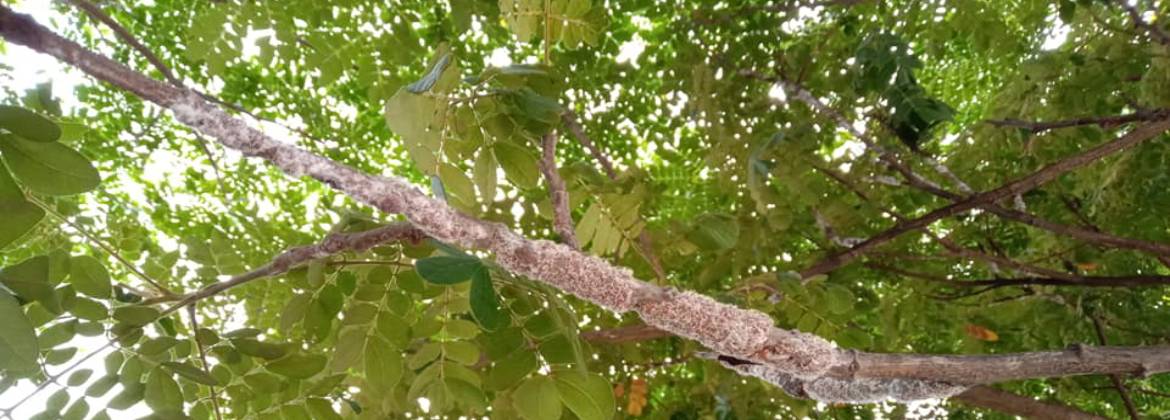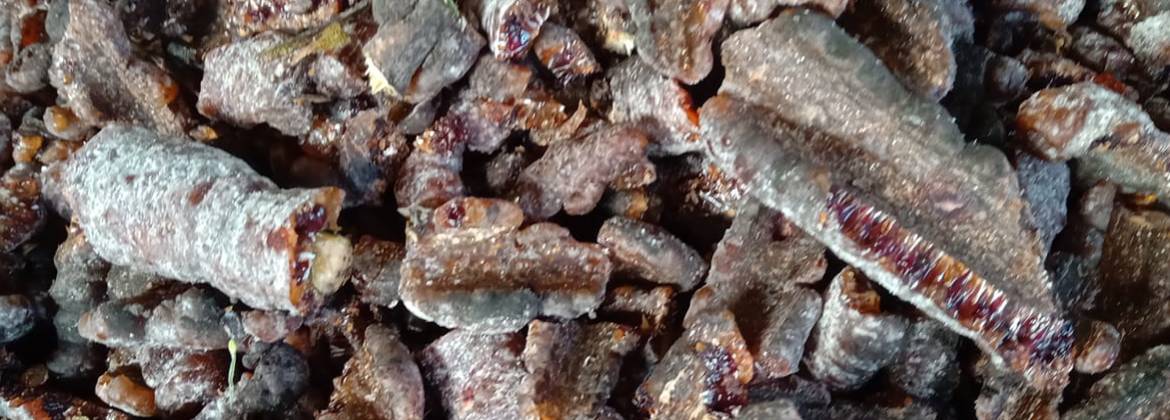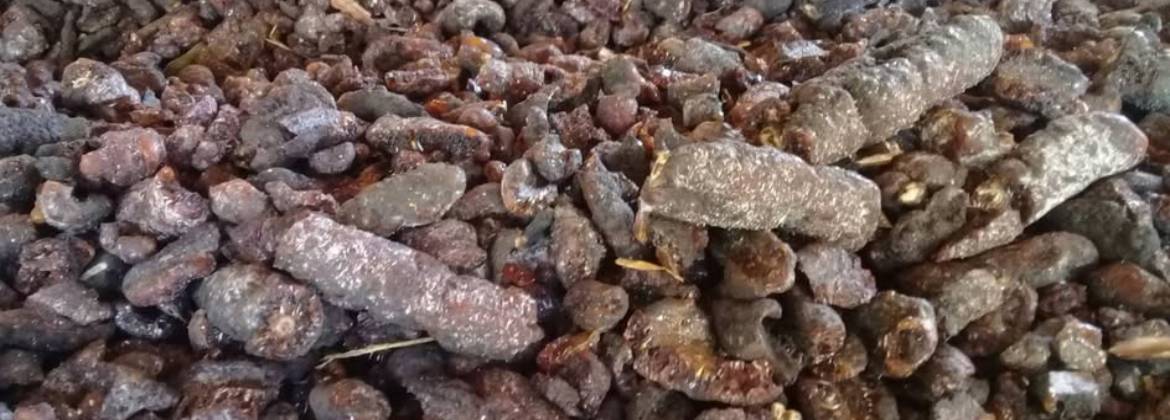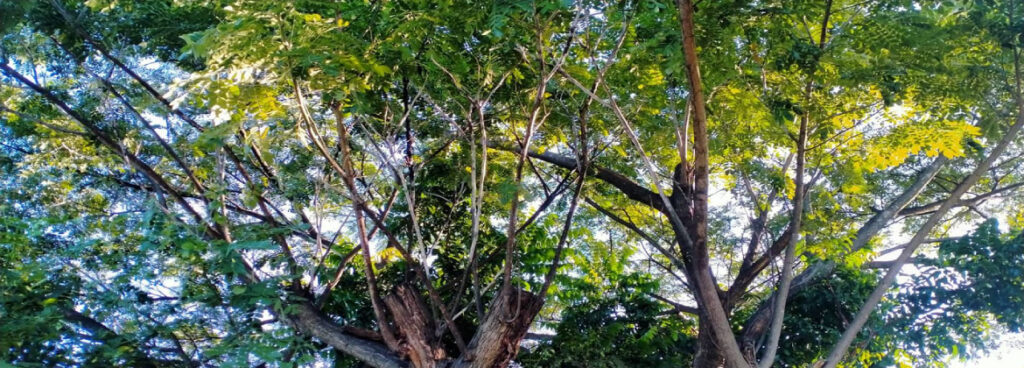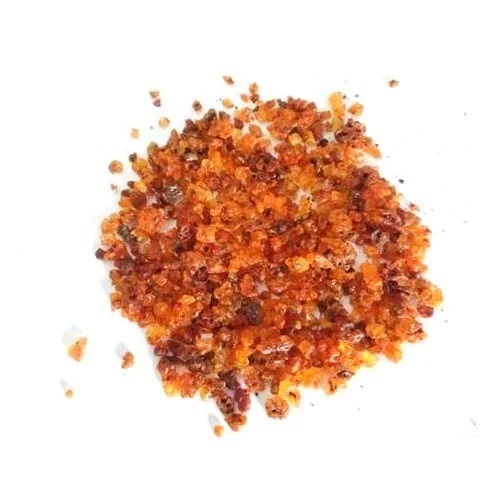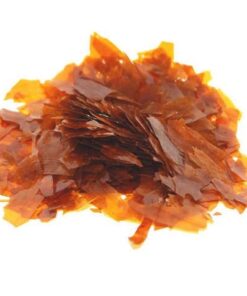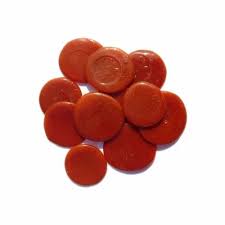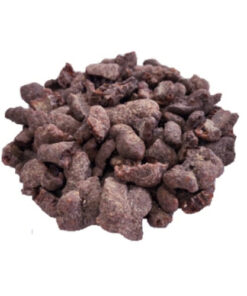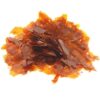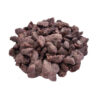Sticklac is the resinous secretion of a kind of tiny insect known as Laccifer lacca.
During harvesting, the lac encrusted twigs are cut from the host plants. Then the lacs are removed from the twigs by scrapping. The lac thus obtained is known as stick lac or scrapped lac or crude lac or raw lac, that contains insect body, lac dye, sand and twig debris, in addition to resins.
If harvesting is done before emergence of larvae, then the lac obtained is referred to as Arilac. The stick lac, if required, can be stored on the floor in layers, less than 30 cm in height and racked frequently.
Raw Lacca in Vietnam is harvested in the high land. There are 2 season one years, so it is always available.
How to produce Seed Lac:
Stick lac, if stored for long time, may form lump due to its high moisture content and may invite other storage pests, and thereby causes substantial loss and deterioration in quality of desired industrial demands. So seed lac is produced from the stick lac by further processing.
Stick lac is first crushed in a machine and sieved to remove sand and dust. Once the sieving is done the crushed stick lac is fed by basket into a Barrel Washing Machine. The loading time taken is generally 15-20 minutes. Capacity of loading at a time of the barrel is its (diameter x length)/2.
This washing removes the dye from the sick lac and also removes other materials like sand, wood impurities and insect body. The process usually takes around two to three hours to complete. It uses a lot of water and the rotary device inside the barrel, helps the churning of the stick lac and helps in the cleaning process.
The water that comes out of the barrel is often taken onto a field and is allowed to dry down. The contents are sometimes used as pesticides and fertilizers. However, the use is much restricted nowadays. The washing time and the methods adopted to do this improves the quality of the seed lac.
Different types of washing are done for different grades single wash for low quality, double wash for medium quality and triple wash for superior quality:
(a) Single Wash:
This involves simple washing without or with negligible amount of soda for some 45 minutes,
(b) Double Wash:
Soda cleaning (750 gm for 500 kg) with low quantity of water for 20 minutes. Water is poured into the barrel from the top through pipe for about 25 minutes and stopped when colour of water passing through a 60 no. net at the back side of the barrel appears white.
(c) Triple Wash:
Water cleaning for 20 minutes. Soda washing (1 kg for 500 kg material) for 1 hour (superior quality) or 45 minutes (medium quality). Then again water cleaning for another 30 to 35 minutes. This is done till the water coming out of the barrel shows no pigment.
After the completion of washing, the bottom part of the barrel is opened and the total mass is poured into a circular cemented basin (size of the basin depends upon the capacity of the washer). The mas¬ses thereafter are filtered through cloth (different quality of cloth is used for different grade). After removing the lighter impurities (‘Khari’ or ‘Pati’) from the mass, seed lac is collected.
The seed lac is then spread into the open cement floor for drying. The layer of seed lac is continuously rolled over the floor from one side to the other side with the help of a ‘Patri’ (a wooden flat strip having a long handle) for facilitating the drying.
The process of drying would take between an hour or two. Usually the washing should not go beyond 2 p.m. so that the finished product is dried by the end of the day.
After drying, the material is sieved through a number of Chaluni’ (circular hand operated sieving tools. Each of them are of different size and helps sieve of the seed lac based on the size of the sieve. The residue so left out at this stage is called the ‘Kuni’ and ‘Molamma’.
Then all materials so sorted out are gathered and remaining impurities are cleaned using the hand operated winnowing baskets (bamboo made instrument called ‘Kulo’) usually done by women.
The seed lac is obtained in the form of grain of 10 meshes or smaller, and yellow or reddish brown in colour. Different grades of hand-made seed lacs are available in market like genuine Baisakhi, Fine baisakhi, Golden baisakhi. Golden Kusmi, Golden Kusmi-bold grain, Manbhum fine seedlac, etc.
Specification


SPECIFICATIONS
PARAMETERS
|
UNIT
|
SPECIFICATIONS
|
Matter Insoluble in Hot
Alcohol (%) – BASIC LIMIT
|
%
|
<=3.0
|
Matter Insoluble in Hot
Alcohol (%) – RELAXED LIMIT
|
%
|
<=4.0
|
Flow rate (mm)
|
mm
|
> 40.0
|
Life (Heat Polymerization)
(minutes)
|
minutes
|
> 25.0
|
Moisture (%)
|
%
|
<=2.5
|
Colour Index
|
Max
|
8.0 – 10.0
|
Bleach Index
|
As agreed
|
As agreed
|
Matter Soluble in Water (%)
|
%
|
<1.0
|
Ash
|
As agreed
|
As agreed
|
Wax (%)
|
%
|
<5.5
|
Storage: Store in airtight containers in cool & dry place away from light & heat.
Caution: Avoid contact with eyes, inner ears, and sensitive areas.
MSDS

MATERIAL SAFETY DATA SHEET
(according to Regulation (EU) No. 1907/2006)
Product name: Seedlac
1. IDENTIFICATION OF SUBSTANCE/PREPARATION & COMPANY.
Product name: Seedlac
Manufacturer/Supplier: Vietnam Essential Oil., JSC
Add: Bai Dai Village, Tien Xuan Commune, Ha Noi City, Vietnam
Emergency telephone: +84 903561868
Emergency Contact: Mr. Peter Tron
2. COMPOSITION / INFORMATION ON INGREDIENTS.
Definition/Botanical Origin: Sticklac is the resinous secretion of a kind of tiny insect known as Laccifer lacca original Vietnam.
Composition: 100% pure & natural, raw material
CAS No: 9000-59-3
3. HAZARDS IDENTIFICATION:
This product is not hazardous. Not dangerous for the environment.
H304 May be fatal if swallowed and enters airways
H315 Causes skin irritation
H317 May cause an allergic skin reaction
H319 Causes serious eye irritation
4. FIRST-AID MEASURES:
Inhalation: Remove from exposure site to fresh air. Keep at rest. Obtain medical attention.
Eye contact: Rinse immediately with plenty of water for at least 15 mins. Contact a doctor if symptoms persist.
Skin contact: Remove contaminated clothes. Wash thoroughly with soap & water, flush with plenty of water. If irritation persists, seek medical advice.
Ingestion: Rinse mouth out with water. Seek medical advice immediately.
Other: When assessing action take Risk & Safety Phrases into account (Section 15)
5. FIRE FIGHTING MEASURES.
Extinguishing media Use CO2, Dry Powder or Foam type Extinguishers, spraying extinguishing media to base of flames. Do not use direct water jet on burning material.
Special measures: Avoid vapour inhalation. Keep away from sources of ignition. Do not smoke. Wear positive pressure self-contained breathing apparatus & protective clothing.
Extinguishing procedures: Closed containers may build up pressure when exposed to heat and should be cooled with water spray.
6. ACCIDENTAL RELEASE MEASURES.
Personal precautions: Avoid inhalation & direct contact with skin & eyes. Use individual protective equipment (safety glasses, waterproof-boots, suitable protective clothing) in case of major spillages.
Environment precautions: Keep away from drains, soils, surface & groundwaters.
Cleaning up methods Remove all potential ignition sources. Contain spilled material. Cover for spillages: with an inert or non-combustible inorganic absorbent material, sweep up and remove to an approved disposal container. Observe state, federal & local disposal regulations.
7. HANDLING & STORAGE.
Precautions in handling: Apply good manufacturing practice & industrial hygiene practices, ensuring proper ventilation. Observe good personal hygiene, and do not eat, drink or smoke whilst handling.
Storage conditions: Store in tightly closed original container, in a cool, dry & ventilated area away from heat sources & protected from light. Keep air contact to a minimum.
Fire protection: Keep away from ignition sources & naked flames. Take precautions to avoid static discharges in working area.
8. EXPOSURE CONTROLS/PERSONAL PROTECTION.
Respiratory protection: Avoid breathing product vapour. Apply local ventilation where possible.
Ventilation: Ensure good ventilation of working area.
Hand protection: Avoid all skin contact. Use chemically resistant gloves if required.
Eye protection: Use safety glasses.
Work/Hygiene practices: Wash hands with soap & water after handling.
9. PHYSICAL & CHEMICAL PROPERTIES.
Appearance: Dried resin
Colour: Orange-amber to brown resinous mass
Odour: Typical
Specific gravity at 20℃: not available
Refractive Index at 20℃: not available
Optical rotation at at 20℃: not available
Main components: Resin
Solubility: Insoluble in water./ Solubility in alcohol, solvents
10. STABILITY & REACTIVITY.
Reactivity: It presents no significant reactivity hazards, by itself or in contact with water. Avoid contact with strong acids, alkali or oxidising agents.
Decomposition: Liable to cause smoke & acrid fumes during combustion: carbon monoxide, carbon dioxide & other non-identified organic compounds may be formed.
11. TOXICOLOGICAL INFORMATION.
According to current information, not classed as hazardous to health in normal industrial use.
12. ECOLOGICAL INFORMATION.
Biodegradability: Data not available
Precautions: Prevent surface contamination of soil, ground & surface water.
13. DISPOSAL CONSIDERATIONS.
Avoid disposing to drainage systems and into the environment. Seek expert advice.
14. TRANSPORT REGULATIONS.
Shipping by road (ADR/RID): This product is not considered as dangerous goods
Shipping by air (IATA): This product is not considered as dangerous goods
Shipping by sea (IMDG): This product is not considered as dangerous goods
UN number: not regulated
UN proper shipping name: not regulated
Transportation hazard class: not regulated
Label: Sticklac Resin
15. REGULATORY INFORMATION. According to Directive 88/379/EEC
Hazards: Harmful
Symbols: n/a
Risk Phrases: Harmful if swallowed
Safety Phrases: If swallowed seek medical advice immediately and show the container / label
16. OTHER INFORMATION.
Cosmetics Directive – 7th Amendment – Not Restricted
Check maximum usage levels for skin care products.
PACKAGING:
In Jute bag 30-50kg
SHELF LIFE:
Best before of 24 months from the date of manufacturing.
Q.C. REQUIREMENTS.
In-line with general product specification. Always satisfy suitability for specific application.
The data provided in this material safety data sheet is meant to represent typical data/analysis for this product and is correct to the best of our knowledge. The data was obtained from current and reliable sources, but is supplied without warranty, expressed or implied, regarding its’ correctness or accuracy. It is the user’s responsibility to determine safe conditions for the use of this product, and to assume liability for loss, injury, damage or expense arising from improper use of this product. The information provided does not constitute a contract to supply to any specification, or for any given application, and buyers should seek to verify their requirements and product use.
Certificate of Analysis


CERTIFICATE OF ANALYSIS
No: 12/ 2024/SLAC
Product name
|
SEEDLAC
|
Cas No.
|
9000-59-3
|
Manufacturing date
|
12/2024
|
Expiry date
|
12/2027
|
Origin
|
Vietnam
|
Batch No.
|
SLAC1224
|
PARAMETERS
|
UNIT
|
SPECIFICATIONS
|
Matter Insoluble in Hot
Alcohol (%) – BASIC LIMIT
|
%
|
<=3.0
|
Matter Insoluble in Hot
Alcohol (%) – RELAXED LIMIT
|
%
|
<=4.0
|
Flow rate (mm)
|
mm
|
> 40.0
|
Life (Heat Polymerization)
(minutes)
|
minutes
|
> 25.0
|
Moisture (%)
|
%
|
<=2.5
|
Colour Index
|
Max
|
8.0 – 10.0
|
Bleach Index
|
As agreed
|
As agreed
|
Matter Soluble in Water (%)
|
%
|
<1.0
|
Ash
|
As agreed
|
As agreed
|
Wax (%)
|
%
|
<5.5
|
Storage: Store in airtight containers in cool & dry place away from light & heat.
Caution: Avoid contact with eyes, inner ears, and sensitive areas.


